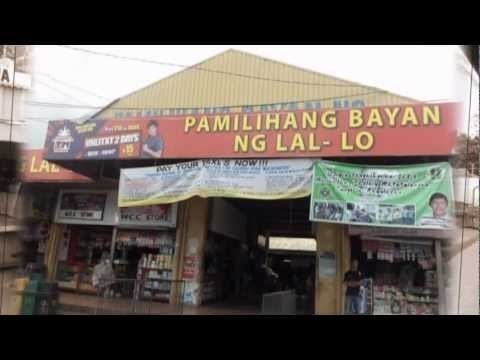Country Philippines Barangays ZIP code 3509 Local time Sunday 5:51 AM | District 1st District Time zone PST (UTC+8) Area 702.8 km² Province Cagayan | |
 | ||
Region Cagayan Valley (Region II) Weather 24°C, Wind NE at 14 km/h, 90% Humidity Neighborhoods Maluyo, Duggil, Magapit, Santa Maria, Lafu, Masi, Binag | ||
Lal-lo is a first class municipality in the province of Cagayan, Philippines. According to the 2015 census, it has a population of 44,506 people.
Contents
- Map of Lal lo Cagayan Philippines
- Barangays
- Etymology
- Spanish Era
- Diocese of Nueva Segovia
- Provincial capital
- Cityhood
- Demographics
- Education
- References
Map of Lal-lo, Cagayan, Philippines
During the Spanish colonial period, Lal-lo was known as the City of Nueva Segovia and was the seat of the Diocese of Nueva Segovia before it was moved to Vigan in Ilocos Sur. There is a recent move in the Philippine Congress to rename Lal-lo back to its former name and reclassify the municipality again as a component city.
The current mayor of Lal-lo is Florante 'Anteng' Pascual, spouse of former Mayor Olivia Pascual, now a board member of the 1st district of Cagayan.
An international airport is currently being built in the southern part of Lal-lo. The Northern Cagayan International Airport is constructed to support the Cagayan Special Economic Zone in northern Cagayan and will also serve the seaborne traffic through Port Irene. The airport project involves the construction of a 2,200-meter runway, with a width of 45 meters, following the standards of the International Civil Aviation Organization. Once completed, the international airport can accommodate large aircraft such as the Airbus A319-100 and Boeing regional jets of comparable size.
Barangays
Lal-lo is politically subdivided into 35 barangays.
Etymology
Lal-lo means "twisting two strands to make a rope", or may also refer to the strong river current as it is located along Cagayan River, the longest and largest river in the Philippines.
Spanish Era
The first European to set foot on what is now the town of Lal-lo is Juan de Salcedo, the Spanish conquistador and grandson of Miguel Lopez de Legazpi, in 1572. Don Juan Pablo Carrion established it as a pueblo (municipality) in 1581 and named it Nueva Segovia. The reason is currently unknown, as the hometown of this Spanish soldier was Carrión de los Condes (Palencia, Spain), as his last name, Carrión, suggests. This is mentioned by Juan Aguilera and Ángel Miranda in their book "Espadas del Fin del Mundo" (2016).
Diocese of Nueva Segovia
In 1595, Pope Clement VIII created the Diocese of Nueva Segovia and in 1596, the Dominicans accepted it as an ecclesiastical mission. Nueva Segovia had three churches: the cathedral that was under the secular clergy, and the parishes of Bagumbayan and Tocolona under the supervision of the Dominicans. But because of its distance from Manila and the constant threat of the Cagayan River’s rampaging waters, the Diocese of Nueva Segovia was transferred to Vigan in Ilocos Sur province in 1758. The diocese’s name went along with the transfer to Vigan and to avoid confusion, Bishop Miguel Garcia requested that Nueva Segovia and its suburbs renamed back to Lal-lo. The seat of the Diocese of Nueva Segovia remains in Vigan till today where is now elevated as the Archdiocese of Nueva Segovia.
The transfer affected the closure of the cathedral and the merging of the three churches into the single parish of Bagumbayan. The two other churches were abandoned and eventually destroyed because of neglect while the church of Bagumbayan, dedicated to Sto. Domingo de Guzman (Saint Dominic) became what is now the present church of Lal-lo. The remains of three bishops are interred in the church: Bishop Miguel de Benavides who was Nueva Segovia’s first bishop and later of Manila where he founded the University of Santo Tomas, Bishop Diego de Soria who was the second bishop of the diocese, and Bishop Diego Aduarte who was the sixth.
Provincial capital
Lal-lo used to be the capital of Cagayan province until 1839 when the provincial seat of power was relocated to Tuguegarao. The decline of Lal-lo is the transformation of Tuguegarao as the most important town in Cagayan. It was accepted as an ecclesiastical mission by the Dominicans in 1604, 23 years after the foundation of Lal-lo.
Cityhood
Researchers have found a Spanish document which declared this municipality as a city during the Spanish regime, according to board member Maria Olivia Pascual. Pascual said a bill, which clamors for the restoration of the former Ciudad Nueva Segovia now called Lal-lo filed by 1SR Congressional District Representative Juan Ponce Enrile Jr., will be re-filed.
During the first term of Mayor Florante Pascual, he resolved that the cityhood be restored through an earlier bill filed by Enrile. However, even after sending a research delegation to Madrid to retrieve the historical document originally signed by King Philip, the team failed to locate it. The document is a basic requirement in the bid of this town for cityhood.
Under the local government code, municipalities who want to elevate themselves into cities must satisfy requirements on population, land area and income. For municipalities who were earlier declared as Spanish cities, only decrees which declared them as such is the basic requirement. Earlier, the towns of Naga (Nueva Caceres) and Vigan (Ciudad Fernandina) were elevated to cityhood status after both towns applied for their historical rights in the early 1990s. Academics clarified that there is a big difference between restoration and conversion of cities under Philippine laws.
Under the Diocese of Nueva Segovia, Lal-lo enjoyed lavish gifts from Spain and was the capital of the entire Cagayan Valley region until its transfer to Tuguegarao City in 1839.
Demographics
In the 2015 census, the population of Lal-lo, Cagayan, was 44,506 people, with a density of 63 inhabitants per square kilometre or 160 inhabitants per square mile.
